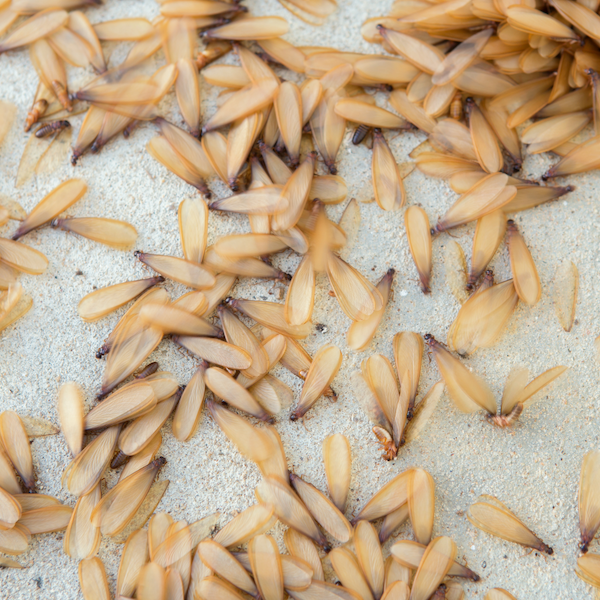The sight of “white ants in wood” can concern homeowners. The presence of tiny, white insects tunneling through wooden structures can often cause worry and confusion. However, what many homeowners perceive as white ants might not be ants.
Instead, they are most likely encountering termites, silent destroyers notorious for their appetite for wood and capacity to cause substantial structural damage.
This blog aims to dissect the misconception surrounding the existence of white ants, reveal the true identity of these pests as termites, and shed light on their impact on wooden structures. Understanding the difference between ants and termites is crucial in implementing effective pest control measures and safeguarding homes from potential damage.
The Myth of White Ants: Understanding the Misconception
The term “white ants” often stems from mistaking termites for ants, especially during swarming events when winged members, called swarmers or alates, take to the sky for a mate. During this event, mated queen termites and ants attempt to establish colonies nearby.
Spotting the differences involves noting the specific traits and characteristics of each pest. Termites typically have straight bodies, straight antennae, and an even waistline, whereas ants have segmented bodies, curved antennae, and a pinched waist. Termite swarmers’ wings are equal in length, extending beyond their bodies, unlike ants with unequal wing lengths.

Let’s delve into the world of real troublemakers—termites. These pests are notorious for their appetite for cellulose-rich materials such as wood and paper, posing a significant threat to homes and structures. While most ant species, excluding carpenter ants, typically don’t cause damage to homes or wooden structures, termites stand out as a formidable threat.
So, who’s behind the damage?
Within termite colonies lies a highly structured social hierarchy comprising workers, soldiers, nymphs, a queen, a king, and reproductive swarmers. While workers and soldiers play crucial roles in defending the colony, the tireless consumption of wood by the workers inflicts the most harm on buildings and structures. Their insatiable hunger for wood can compromise the structural integrity of homes, leading to severe and costly damage if left unchecked.
For more information about termites’ life cycle and their role in the colony, check out our blog, “4 Stages of the Life Cycle of Termites.”
Existence of White Ants: A Myth Debunked
The term “white ants” is a bit of a misleading term. In reality, those so-called ants are almost always termites. There aren’t any ant species that match the bill, as most are different shades of black, brown, or red.
So, what causes the confusion? Termite swarmers can resemble certain types of ants during their swarming phase. Their semi-transparent wings and bodies can make them appear similar to other insects, leading to the misconception of “white ants.”
However, this mistake isn’t benign. When homeowners brush aside a termite infestation, thinking they’re harmless ants, termites can continue their destructive path and harm the home’s foundation.
Pest Control Strategies: Combatting Termites in Wood
The misconception surrounding “white ants” as a separate pest species remains a prevalent myth. In truth, what homeowners may mistake for white ants in wood are termites, destructive insects capable of wreaking havoc on wooden structures.
Understanding the true nature of these pests—recognizing termites as the actual culprits and dispelling the myth of white ants—is pivotal in implementing effective pest control measures.
Termites’ ability to feed on wood and other cellulose materials makes them formidable adversaries to wooden structures. These pests can cause extensive damage without showing visible signs on the surface, hollowing out beams, walls, and foundations over time.
Infestations often remain unnoticed until severe damage becomes apparent, prompting costly repairs. The insidious nature of termites highlights the necessity of proactive measures and regular inspections to detect their presence before significant structural damage occurs.
Eradicating termites from wooden structures demands targeted and thorough pest control strategies. Prevention remains the most effective approach, involving regular inspections, minimizing moisture around the property, and addressing wood-to-soil contact, which can attract termites.
Professional pest control services specializing in termite extermination and prevention are crucial in effectively combating infestations. They employ various methods, including termite baits, liquid termiticides, and physical barriers, tailored to the specific type of termites and the severity of the infestation.
When you have termite infestations, turn to the experts at proof. Pest Control for help. We have what it takes to eliminate termites and keep them away with our top-notch preventive treatments.
But what about ants? To prevent ants, keep surfaces clean, store food in sealed containers, and seal cracks or openings where ants may enter. Use natural deterrents like cinnamon or vinegar. Regularly inspect and address moisture sources to deter ant infestations. Our skilled technicians can help you with tough ant infestations, too!
Continued vigilance, regular inspections, and collaboration with the pest control experts at proof. are essential components of a proactive approach to prevent and combat termite infestations

